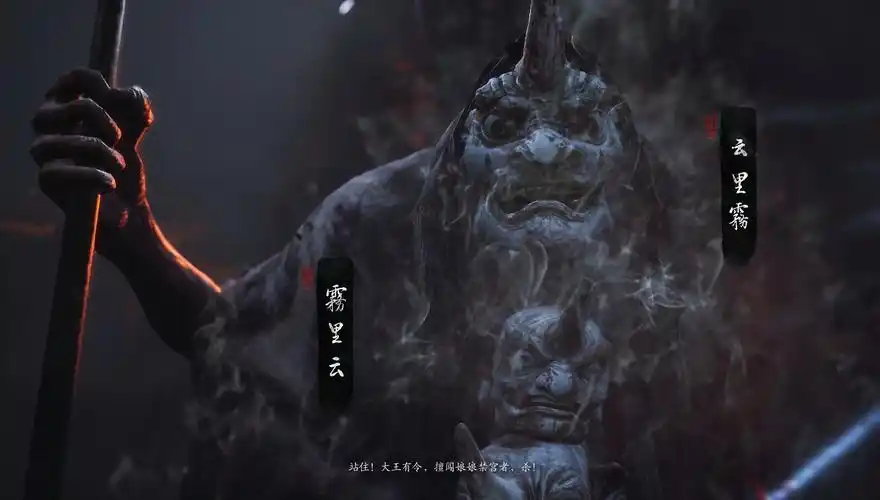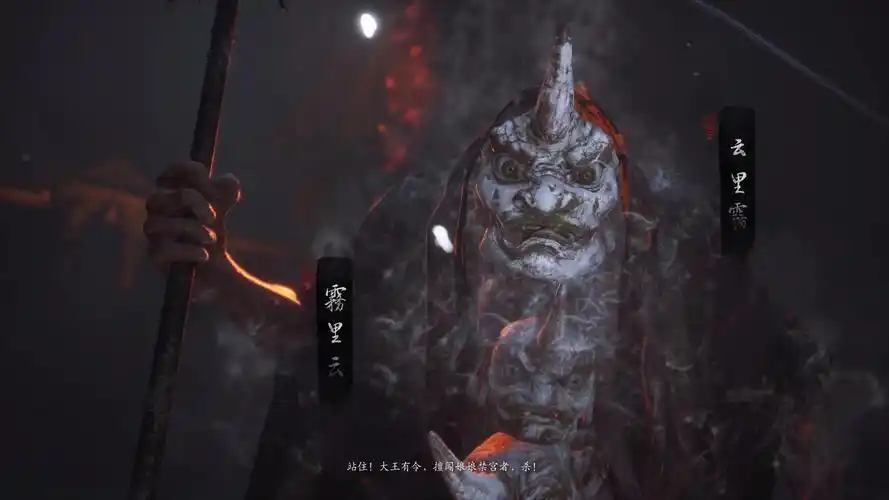In this episode, the Destined One will encounter several bosses including Flint Chief, Cloudy Mist, Misty Cloud, and the Keeper of the Flaming Mountains. This chapter introduces the first three characters mentioned.
Flint Chief was created by the Keeper of the Flaming Mountains for Red Boy. In the Flaming Mountains, the Keeper shows the most indulgence towards Red Boy. One day, Red Boy demanded a counterpart like the Stone Vanguard from Yellow Wind Ridge for himself. Without hesitation, the Keeper agreed, fearing that the Stone Vanguard alone wouldn’t be enough to entertain Red Boy. He whimsically added many Stone Guai, among which one was giant-sized, with two arms and legs strong enough to support its stony body. This colossal Stone Guai, more formidable than the average, usually lies dormant in the river of fire. It emerges only when formidable intruders appear or when summoned by its master. However, Red Boy was not particularly fond of this batch of specters created by the Keeper without his consent, and mostly interacted only with Flint Chief.
Flint Chief here, much like Mother of Stones at Yellow Wind Ridge before, is a Stone Guai, a kind of creature that has become sentient through stones. Stone Guai commonly refers to a type of creature found in fantasy works, mythology, or games. They primarily feature or consist of stone, often depicted as opponents with high defense and difficult to handle.
The bodies of Stone Guai are typically made of rocks, stones, or minerals, and their appearances may include natural attachments like moss or lichen. They vary in size, ranging from human-sized to giant-like enormities. Depending on their environment, the color of Stone Guai can be gray, brown, black, or other natural rock colors. Due to their bodies being composed of hard rocks, Stone Guai usually have very high defense, particularly resistant to physical attacks. They often possess immense strength, capable of easily moving large boulders or causing tremors. In some settings, Stone Guai may have high resistance to certain elemental attacks, such as fire or electricity. Some Stone Guai can draw stone materials from their surroundings for self-repair or reconfiguration.
Due to their heavy bodies, Stone Guai generally move slowly and have a lower attack speed. Some Stone Guai might be vulnerable to specific elemental attacks, such as water or ice, depending on the particular setting. In some settings, Stone Guai have weaker resistance to magical attacks, especially those destructive Magic spells targeting rocks.
Stone Guai appears in myths and legends around the world, such as the giants in Norse mythology and the stone monsters in Greek mythology. In novels, movies, and video games, Stone Guai often emerges as an enemy or challenger. For example, the gargoyles in “The Lord of the Rings” and the stone elementals in “World of Warcraft.” In some stories, Stone Guai are cast as guardians of ancient relics or treasures. They may represent the power of the Earth, acting as protectors or avengers of nature. In games, Stone Guai are typically designed as formidable foes that players must defeat. Stone Guai plays a versatile and dynamic role due to its unique appearance and characteristics, making it an important character in various creative works.
Cloudy Mist and Misty Cloud are characters from the Six Champions of the Cave of Fire Cloud, originating from the novel “Journey to the West.” In the novel, these six champions serve under Red Boy. The game “Black Myth” has further adapted the backstory of these two characters.
Once, there were three Ghosts sharing one body, who aspired to earn the status of a Mountain God. They made the right connections and targeted a blind Mountain God of a certain mountain. Although the Mountain God was blind, he had exceptionally sharp hearing and was highly skilled in pyrotechnics, capable of releasing smoke to conceal his movements. Whenever the three Ghosts came to challenge him, he would immediately hide. One time, the three Ghosts fought with the Mountain God, struggling embarrassingly, and were ridiculed by Red Boy who witnessed the scene.
The three Ghosts and the Mountain God, infuriated and embarrassed, temporarily set aside their grudges to confront Red Boy. Finding the skirmish amusing, Red Boy wielded his sharp spear and exchanged a few moves with them. Unexpectedly, the Mountain God’s smoke was perfect for concealing the clumsy bodies of the Ghosts, and the Ghosts’ lightning strikes created opportunities for the Mountain God to attack. Thus, they managed to hold their own against Red Boy for several rounds until Red Boy unleashed the Samadhi True Fire, forcing them to the ground to beg for mercy. Thereafter, Red Boy recruited them as his elite warriors. Since then, the three Ghosts were given a new name, Cloudy Mist, and the blind Mountain God was bestowed the name Misty Cloud. Together, they served Red Boy.
So, what exactly was the Divine Duty that the three Ghosts were striving to attain? The Mountain God refers to a deity or guardian worshiped in many cultures and religions as the overseer of mountains. Across different cultural contexts, the depiction and characteristics of the Mountain God vary, but generally, they are closely associated with nature, harvest, and human life.
In traditional Chinese culture, the Mountain God is part of nature worship, believed to control the fortunes and misfortunes of the mountains. Typically depicted as a protector of local land and residents, temples are often built at the base or summit of mountains to Offer sacrifice to the Mountain God. Ceremonies to worship the Mountain God usually occur during planting in spring and harvesting in autumn, or at the start of construction projects, seeking blessings and abundant harvests. The Mountain God often symbolizes the power and majesty of nature, and worship of the Mountain God expresses reverence for nature. The Mountain God also symbolizes community unity and cultural identity, as the activities associated with worshiping the Mountain God are often communal.
In modern times, the concept of the Mountain God is frequently used in literature and film to symbolize the mysterious powers of nature. The Mountain God is often portrayed as a protector of the environment, playing a significant role in harmonious coexistence between humans and nature. With a rich variety of symbolic meanings and religious roles in different cultures, the Mountain God reflects humanity’s awe and faith in nature.
